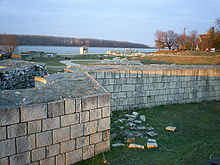Siege of Dorostolon

Svyatoslav's fighters during the siege of Dorostulum ( Henryk Siemiradzki , history painting 19th century)
| date | 971 |
|---|---|
| place | Dorostolum |
| output | Byzantine victory |
| Parties to the conflict | |
|---|---|
| Commander | |
| Troop strength | |
| approx. 40,000 | approx. 60,000 |
| losses | |
|
unknown |
approx. 38,000 |
The siege of Dorostolon ( Silistra ) took place in 971 between the Byzantine Empire and the Kievan Rus . The Byzantines, led by Johannes Tzimiskes , won the battle.
As a result of the Russo-Bulgarian War, Grand Duke Svyatoslav I of Kiev conquered the northern parts of the Byzantine Empire and founded his new capital Pereslavets on the lower Danube . When Johannes Tzimiskes had successfully usurped the throne, the Byzantines attacked the troops of Kievan Rus and the Bulgarians allied with him . After John had succeeded in defeating the united forces of Russia and the Bulgarians in the battle of Arkadiopolis , Svyatoslav fled to the fortress of Dorostolon ( Drustur / Durostorum ).
John immediately began the siege of Dorostulum, which was to last a total of 65 days. His army was reinforced by 300 ships armed with Greek fire . These ships were u. a. used to secure the Danube and its delta. In the course of the battle, there were some minor skirmishes outside the walls of the city, which revealed the weakness of the Russian cavalry . Nevertheless, the besieged managed to kill a relative of the emperor, Johannes Kurkuas, in one of these skirmishes and then impaled his head on one of the city towers in a clearly visible manner.
However, due to the long siege and the associated famine, the Rus and their allies, not prepared for a siege, lost many men. 2000 men and some women managed to break out and return to get food, but this did not significantly prolong the siege. Even the invocation of the gods, during which chickens and allegedly even children were sacrificed in the Danube, no longer helped the besieged.
After realizing their hopeless situation, they surrendered and signed a peace treaty with the Byzantine Empire. In it the Rus had to give up their claims to Bulgaria, Hungary and Chersonese in the Crimea . On the retreat to the island of Berezan , Svyatoslav also had to accept the apostasy of the Magyars and Pechenegs allied with him . After the arrival of the Byzantines, the city of Dorostolon was renamed Theodoropolis after the wife of the emperor.
The course of the battle was described in the Nestor Chronicle and the Chronicle Synopsis Historion of Johannes Skylitzes and processed in a literary drama by the Turkish writer Namık Kemal in the 19th century .
literature
- Andrey Nikolayevich Sakharov. Svyatoslav's Diplomacy . Moscow: Mezhdunarodnye otnosheniya, 1982.
- Fyodor Uspensky. The History of the Byzantine Empire , vol. 2. Moscow: Mysl, 1997.

